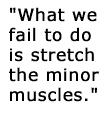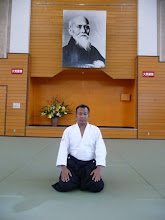Thursday, May 20, 2010
Announcement 2/2010
Training will resume on 2nd June 2010.
Friday, May 14, 2010
On Stretching - An article by Bruce Everett Miller
Stretching As An Important Tool In Preventing Martial Arts Trauma
By Bruce Everett Miller, PA-C
The issue of health to the martial artist is one that carries a lot of emotional impact. Whether it is because of illness or because of injuries, when we are not in full health we cannot, in most cases, enjoy the martial arts we love best.
With as much at stake as all that, there obviously arise a great number of different opinions on both how to both care for our health and restore it once we are sick or disabled. This series of articles will deal with the subject of injuries. Mostly the understanding of injuries and how they relate to the martial artist. Along the way you will find that the more you know about the way your body works, the better you can take care of it and also how you can use someone else's body against him.
There are many different approaches to preventing injuries. Besides the issue of safety, the most commonly agreed upon way to prevent injuries is to stretch before working out. Almost everyone agrees on this point of fact but unfortunately most people have never really been taught how to stretch. For those of you who scoff at the idea of having to be taught how to stretch, then I ask you a simple question. How many times have you pulled a muscle during a work out when you thought you were already stretched out? If the answer is never you are either a master at stretching or lying. Either way you don't need this article.
 For the rest of us, I want to state that the most common fault in stretching is not that we don't stretch, or even stretch the major muscles adequately. What we fail to do is stretch the minor muscles.
For the rest of us, I want to state that the most common fault in stretching is not that we don't stretch, or even stretch the major muscles adequately. What we fail to do is stretch the minor muscles.
The most common non-impact injuries that I see (and/or treat) in martial arts are bone bruises after sparring and those relatively small but very painful muscle pulls or tears. (We will talk about bone bruises in the next article). The main reason for the muscle pulls is that we tend to stretch out joints in the directions which we are used to moving them in. Makes sense so far. What we don't realize is that almost every joint in the body is built to withstand and compensate for some rolling motion as the joint goes through its full range of motion. The major muscles which we are used to stretching are those which are responsible for the major movement of the joint, but the minor muscles are responsible in a large part for keeping the joint aligned. When we don't stretch these minor muscles, we run the risk of pulling or tearing them if we move the joint suddenly in any angle oblique from the normal direction that it was primarily designed to go. This is also what we do to our opponents when we force their joints in ways that they were not designed to go.
Therefore, we need to loosen up these small muscles surrounding each and every joint. The method I recommend is as follows: First, develop a set pattern in your stretching. For example, start with the feet and work upward or vise versa. Secondly, not only stretch each and every joint in its major directions of travel, but also roll each joint in as much of a circular motion as possible. This loosens up the minor muscles we talked about above. Thirdly, make sure that any tension you place on muscles and ligaments during your stretching is done with slowly increasing pressure. Jerky movements should be avoided, because even small jerks can tear the small muscle fibrils which make up each muscle. While this won't cause dramatic pain or limitation of motion, such injuries can add up.
If you work as hard at developing good stretching habits as you do learning a new form, then soon you will have developed a way to dramatically decrease injuries. Even more importantly, correct stretching in itself can make you feel better even after the effects of the rest of the work out have worn off.
The next article on preventing martial arts trauma will continue on the subject of stretching and address the post exercise stretch.
About the Author:
Bruce Everett Miller, PA-C, is a 6th degree black belt in the style of Quan Li K'an and a teacher of Tai Chi which he combines with his Western medical training as a Physician's Assistant to provide his own unique perspective on the martial arts. He is a well known teacher, seminar leader and author who has produced thirteen books and four videos on various karate related subjects including freefighting, pressure points, the principles of kata, Acupuncture, and light force knockouts. For more information on his books, vidoes and seminars see: www.cloudnet.com/~bemiller/
